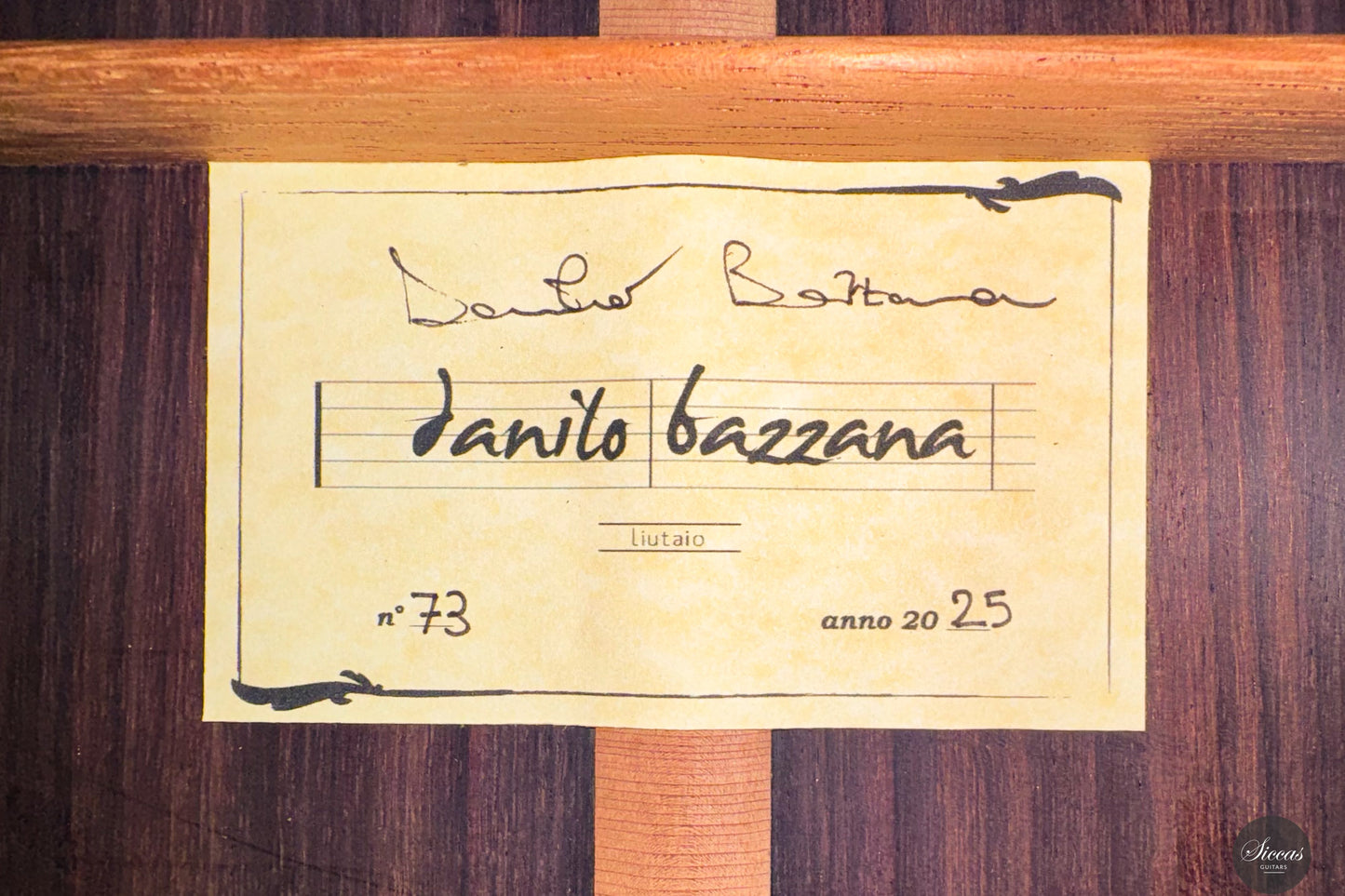Danilo Bazzana - 2025 - No. 73 - 64 cm
Danilo Bazzana - 2025 - No. 73 - 64 cm
Details
Details
Overview
Overview
Shipping important note
Shipping important note
Delivery times are typically reliable and most instruments arrive within the estimated timeframe.
Should any unexpected delay occur, our team will keep you informed and provide support at every step. For all shipping details and exceptions, please see our Shipping Policy.
Details about GPSR
Details about GPSR

























Video overview


More details about the guitar
About the luthier
Danilo Bazzana, born in Milan in 1985, began playing the guitar at the age of thirteen, an early passion that later developed into his career. In 2015 he opened his workshop in Paderno Dugnano, near Milan, where he builds classical guitars and also carries out fine adjustments, restoration, and repair of plucked instruments. His guitars are rooted in the traditional style, inspired by the great masters, yet marked by his meticulous attention to the selection of materials and detail in construction. Bazzana follows the philosophy that every component of a guitar “must vibrate in its entirety,” guiding his search for harmony in sound and integrity in craftsmanship. Influenced by the French school of lutherie, particularly Robert Bouchet and Daniel Friederich, his instruments combine clarity, projection, and sensitivity with elegant design.About the guitar
This 2025 guitar, numbered 73, is a traditionally built instrument with a cedar top and Indian rosewood back and sides, finished with French polish. The sides are doubled with cypress, a feature that enhances projection and attack. The scale length of 640 mm with a nut width of 51.5 mm offers enhanced comfort for the left hand while retaining secure string spacing. At 1395 grams it is lightweight, supporting both sensitivity and projection. The instrument is fitted with Alessi tuning machines and delivered in a hardshell case. The bracing, inspired by French designs, provides both power and clarity. The tonal palette is wide and colorful, with clear separation and crystalline projection, while retaining warmth in the cedar voice. The trebles are luminous, the basses resonant, and the midrange rich, resulting in a sound that is loud yet refined. The response is quick and elastic, giving the impression of an instrument that “breathes” freely and reacts immediately to even small variations of touch. Higher registers maintain fullness and intensity, while polyphonic textures remain balanced and distinct. The sensitivity of the guitar rewards careful right-hand preparation, allowing the performer to shape tone with precision.Regular care extends the life of the instrument
Even with careful use, a classical guitar may gradually change in appearance or respond to unstable storage conditions. Have a close look at your guitar regularly and be attentif to changes. If your instrument is suffering from its environement, it will let you know.
Protect Your Guitar: Handle with Care
Be mindful when touching your instrument with greasy or unwashed hands: any skin contact is a small attack on the varnish. Of course, a guitar is made to be played, but taking a few precautions helps preserve its beauty: wash your hands before playing, wear long sleeves, and avoid unnecessary direct skin contact with the body of the instrument.
Pro tip: Avoid playing with a button-up shirt, heavy jewelry, or a belt, as these can scratch the guitar. Also, make sure your guitar case is free of any objects that could damage the instrument during storage.
String care
A good habit to adopt is wiping down your strings briefly after each playing session. This small action significantly extends their lifespan and helps maintain a consistent, comfortable feel under your fingers.
Most importantly, clean strings are essential for keeping your instrument in tune. Corrosion, sweat, and dust can affect the uniformity of the strings and interfere with accurate tuning across the entire fingerboard.
Pro tip: If you're having trouble getting your guitar in tune, it might be time to change the strings. A useful test is to compare the pitch of the 12th fret harmonic with the fretted note at the 12th fret; if there's an unusually large gap between them, your strings may have lost their integrity and should be replaced.
Keep Your Shellac Finish Shining!
Got a guitar with a shellac (French polish) finish? Here's a simple trick: Take a clean microfiber cloth and gently breathe on the surface to create a light mist. Then, softly rub to remove fingerprints, sweat, and grease. That’s usually all it takes to keep it looking great, no products needed!
Pro tip: Every few years, treat your guitar to a check-up with a luthier to keep it in top shape.
Storing Your Guitar: Climate Matters
Your guitar can safely stay outside its case, as long as the surrounding environment maintains 42–55% humidity and a temperature between 18–25°C.
Keep in mind that humidity levels can still fluctuate inside the case, especially during seasonal changes.
- Too much humidity may cause overtightened strings and a dull tone.
- Too little humidity can lead to a bulging top, string buzz, or even cracks.
Avoid placing your guitar near radiators, air conditioners, or windows with direct sunlight.
Pro tip: Always close your guitar case while playing. This helps preserve a stable microclimate inside the case, so your instrument is protected the moment you put it back in.





















































